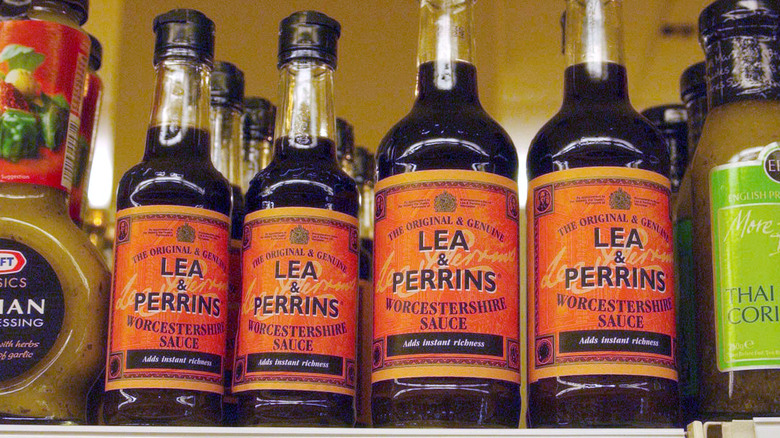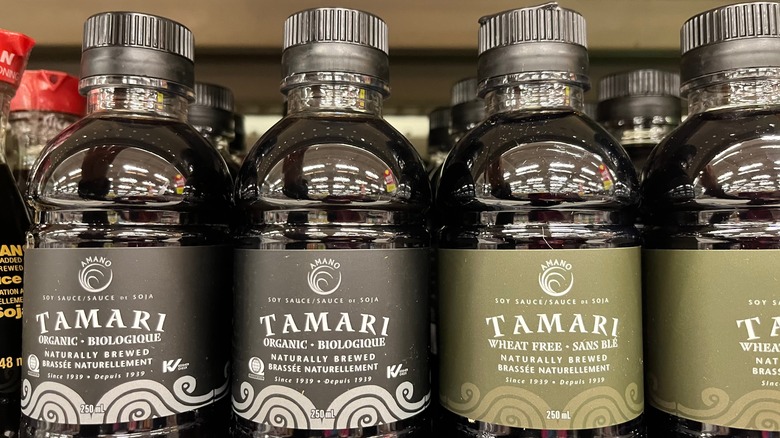The Easy Soy Sauce Substitute That's Already In Your Pantry
If you're in need of soy sauce but don't have the energy to head to the supermarket, fear not: There's a pantry staple that makes for an ideal substitute. Worcestershire sauce is a solid replacement for soy sauce, and you can simply do a one-to-one substitution (that is, use the same amount of Worcestershire sauce as you would soy sauce. The reason this swap works so well is largely due to one shared characteristic: Both sauces are packed with umami, that mouth-watering "fifth" taste, so generally speaking, you're not changing the flavor profile majorly by making this substitution. It also helps that both sauces have relatively salty profiles, and they're fermented, which also helps to maintain the same flavor profile despite the swap.
Of course, ingredient substitutions are an imperfect science, and that's no different here. Be aware that Worcestershire sauce has more ingredients, so you might find it has some additional flavor notes (for example, from anchovies) as compared to soy sauce, which has fewer components. If your recipe really centers around soy sauce, the substitution may not be perfect, since Worcestershire sauce will bring in other flavors, although it's still great if you're just looking for that umami hit. Worcestershire also has a vinegar base. This means that if you're making this substitution, you may want to be careful adding additional vinegar (for example, if you're working with a recipe that calls for soy sauce and vinegar).
What to know about Worcestershire sauce
Although it may be a great soy sauce substitute, Worcestershire sauce comes from a rather different culinary background. With a name deriving from a region of England, Worcestershire sauce is considered a very British condiment. (That said, there are theories that its origins are Indian and that British colonists brought it back to the United Kingdom, although these aren't well-substantiated.)
It's made with a vinegar base, and the main flavorings in the sauce are garlic, onion, molasses, anchovies, and tamarind (which is a decidedly non-British ingredient that could be linked to India). It may have smaller amounts of other spices like cloves, too. It's little surprise then, that Worcestershire sauce brings in extra flavors compared to soy sauce because it has some relatively pungent ingredients. Soy sauce, which hails from China (but is now widely used across East Asia), has a simpler ingredient list, with a soybean paste, wheat, salt, water, and an ingredient like yeast that helps it ferment (whether it's yeast or something else varies across recipes). Worcestershire sauce is used fairly widely, usually to add that extra umami flavor layer to all sorts of recipes from broths and stews to vinaigrettes and marinades, whether British or not.
But Worcestershire sauce isn't ideal for everyone
If you're vegetarian or vegan or cooking for one, Worcestershire sauce is obviously not a great substitute, since it has anchovies in it (although there may be vegetarian versions of it available, if you shop around).
But fortunately, it's not the only decent soy sauce substitute out there. Fish sauce is a common recommendation, although it has the same obvious issue in that it's not vegetarian (and will add a noticeable fishy flavor). One excellent option (although less of a pantry staple) is tamari, another soy-based sauce that's common in Japan. It's less salty than soy sauce but has a similar flavor profile, and it's more likely to be gluten-free — soy sauce and Worcestershire sauce are both more likely to contain gluten.
Liquid aminos are another close match: They're made with fermented coconut and salt (or sometimes non-fermented soybeans), and can bring an umami hit, although they're usually a bit milder in flavor and sweeter than soy sauce. Another umami-loaded option is miso, although you may need to work it into a recipe more carefully since it's a paste and not a sauce. Finally, Maggi seasoning is basically like a Swiss version of soy sauce (but made with fermented wheat), but go easy if you're substituting it since it tends to be strong.


